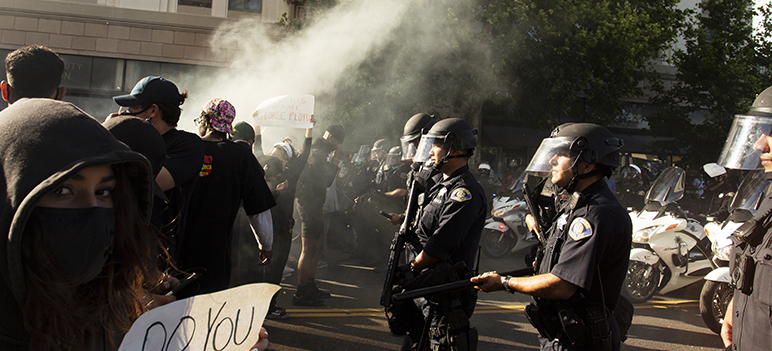The City of San Jose has reached a settlement with the NAACP of San Jose/Silicon Valley, which – if formally approved by the City Council on Sept. 12 – would award $2.9 million to a San Jose man who was blinded in one eye when struck by a rubber bullet fired by San Jose police in 2020.
The settlement was revealed in City Council agenda materials posted late Friday afternoon.
Michael Acosta of San Jose, one of the plaintiffs represented by the NAACP in the lawsuit filed in March 2021, said he lost his left eye when struck by a rubber bullet fired by police on May 29, 2020.
At the time, Acosta said he was photographing a crowd protesting the killing of George Floyd by Minneapolis police. The protests at Eighth and Santa Clara occurred about one block from his home.
After initially pushing back on protestors’ allegations, the city agreed last month to settle the case before trial.
The settlement also includes additional payments totalling $450,000 to a dozen other plaintiffs: Joseph Maldonado, Mahmoudreza Naemeh, Megan Swift, Joseph Cañas, Leslie Vasquez, Peter Allen, Shaunn Cartwright, Yessica Riles, José Gustavo Flores Rodriguez, Cindy Cuellar, NAACP of San José / Silicon Valley,and the San José Peace and Justice Center.
The local civil rights groups and individuals filed a class action lawsuit against the city for injuries caused by police violence during the 2020 George Floyd protests in late May/early June, 2020.
The lawsuit also named then-Mayor Sam Liccardo, former City Manager David Sykes, former San Jose Police Chief Eddie Garcia and other officers as defendants.
The lawsuit alleged that the demonstrators and observers were “brutalized” by San Jose police and met with “racially targeted repression” during the late-May demonstrations.
The goal of the lawsuit was not only financial compensation for all those injured but also “significant reforms of the way that San Jose police are trained and directed to police protests,” plaintiff attorneys said at the time.
The case was filed as a class action “on behalf of all those who were subjected to police violence, including the use of tear gas and other chemical weapons, explosive grenades, impact munitions, and batons; and all those who were arrested for violating the curfew.”
Police deployed more than 600 rubber bullets into crowds of protestors in downtown San Jose from May 29 to June 7, 2020. At the time, the San Jose Police Department leaders defended their actions as a reasonable use of force.
The department’s response to local protests ignited by the killing of George Floyd by Minneapolis police, in which city police rained projectiles and tear gas on hundreds of peaceful bystanders in the first few days of demonstrations, resulted in an immediate and fierce public backlash in San Jose and cities across the country.
Police officials at the time said officers fired the rubber bullets – for the first time in the city’s history – to disperse a dangerous crowd.
The bullets, which the police called “projectile impact weapons…work through blunt force trauma,” according to police at the time. According to the department’s policy, rubber bullets were only to be used under two conditions: to incapacitate a suspect who’s armed with a weapon or in a situation where its use would prevent anyone from being seriously injured.
Police said protestors hurled water bottles, rocks, beer bottles and other objects at officers, creating what officers described as “a war zone” around Eighth and Santa Clara streets.
Despite the backlash to police actions from Liccardo and community activists, the city council voted 10-1, with only Liccardo voting in the negative, in September 2020 to allow city police officers to continue the use of rubber bullets and other projectile impact weapons in some crowded situations if they were directly attacked.
A week after the May/June protests, Garcia banned the use of rubber bullets as a method of crowd control, so officers could no longer use them to control crowds, only to defend themselves.
In September 2022, the California Legislature banned the use of rubber bullets and other projectiles by police officers as a crowd control measure, allowing their use only to defend themselves in life-threatening situations.

